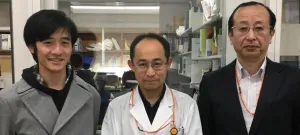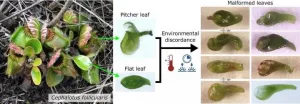Toho university scientists find new mechanism to keep cell death pathway suppressed
2021-01-27
(Press-News.org) In our body, unnecessary cells are removed by regulated cell death. Understanding of the mechanism underlying regulated cell death is critical for the development of therapies for many diseases. Professor Nakano's research group has demonstrated that Mind bomb-2 (MIB2), a ubiquitin ligase, binds to and directly ubiquitinates the cell death suppressor protein cFLIP (Cellular FLICE-inhibitory protein). cFLIP is encoded by CFLAR gene; alternative splicing results in two forms, the long form (cFLIPL) and the short form (cFLIPs). cFLIPL plays a dominant role in suppression of cell death. In MIB2-deficient cells, cFLIPL ubiquitination was attenuated, but its degradation was rather decreased, indicating that MIB2-mediated ubiquitination does not promote cFLIPL degradation. Intriguingly, TNF-induced apoptosis was enhanced in MIB2-deficient cells. Taken together, these results show that MIB2-mediated ubiquitination is necessary for cFLIPL to inhibit cell death. cFLIPL has previously been shown to associate with caspase 8 and inhibit apoptosis. Ubiquitination of cFLIPL by MIB2 may alter the higher-order structure of the complex containing caspase 8, preventing it from forming a large complex, thereby preventing caspase 8 association (Fig. 1).
"The protein cFLIPL has been known to play a central role in the regulation of cell death. We screened hundreds of ubiquitin ligases for the ones that interact with cFLIP protein, and found MIB2. MIB2 has been known to be involved in the Notch signaling pathway," Dr. nakabayashi, lead author of the study said. "Here we found a new role for this ubiquitin ligase. Our study has revealed for the first time that MIB2 is a ubiquitin ligase that acts on cFLIPL, and cFLIPL ubiquitination by MIB2 is essential for the cFLIP's function in suppressing cell death signaling. This research encourages future development of cell death-promoting drugs targeting the interaction between MIB2 and cFLIPL."
"Abnormalities in cell death regulation have been observed in various diseases, including cancers and neurodegenerative diseases. Our study suggests that if we can pharmacologically inhibit cFLIP ubiquitination, we may be able to induce cell death more efficiently in cancer cells," said Prof. Nakano, senior author of the study.
INFORMATION:
These results were published in Communications Biology, on January 19, 2021. This research was conducted in collaboration with Prof. Tatsuya Sawasaki of Ehime University, Dr. Yasushi Saeki of Tokyo Metropolitan Institute of Medical Science, Dr. Fumiaki Ohtake of Hoshi University, and Prof. Fuminori Tokunaga of Osaka City University.
[Attachments] See images for this press release:

ELSE PRESS RELEASES FROM THIS DATE:
2021-01-27
January 27, 2021 - For many of us, as we get older the skin on our face begins to sag and we seem to lose volume around our eyes, cheeks and chin. Is gravity taking its toll in our later years or do we lose fat over the course of several years that many of us associate with youth, vibrancy and energy? Understanding the cause is paramount to how plastic surgeons treat the signs of facial aging.
The traditional theory is sagging: the facial soft tissues simply yield to the effects of gravity over time. And while the idea that weakening ligaments in the midface could result in soft tissue descent still has merit, more recent studies point in another direction. Perhaps the real culprit behind facial aging ...
2021-01-27
Speaking is something that comes across as an effortless process, almost working by itself. Our brain, however, has a lot of work to do when we construct a sentence. "In addition, languages differ in myriad ways and this also means that there are differences in how we plan what we want to say in different languages," says Balthasar Bickel, senior author of the study and a professor at the University of Zurich.
And if some languages seem easier, it is because they make fewer distinctions in their grammar. While English always uses the (e.g., in "The tree is tall" and "Snow covers the tree"), German makes a distinction between der (subject) and den (object) (e.g., in "Der Baum ist groß" and ...
2021-01-27
A fifth basic flavour has crept into our conceptualisation of foods in recent years--umami. In Japanese, umami translates roughly to 'savoury deliciousness'.
It is often associated with the earthy flavours of meat, mushrooms, broths and vine-ripened tomatoes. It enhances saltiness and sweetness, while reducing bitterness, which is why most people love it.
But does umami exist in beverages? And if so, which fermented beverage has the most umami potential: wine, beer, sake or champagne? And, what happens to flavours when these beverages are paired with foods?
Three researchers from the University of Copenhagen's ...
2021-01-27
Researchers from the Hong Kong University of Science and Technology (HKSUST) and the University of Hong Kong (HKU) recently demonstrated that the selectivity determinant of Origin Recognition Complex (ORC) for DNA binding lies in a 19-amino acid insertion helix in the Orc4 subunit, which is present in yeast but absent in human. Removal of this motif from Orc4 transforms the yeast ORC, which selects origins based on base-specific binding at defined locations, into one whose selectivity is dictated by chromatin landscape (genomic nucleosome profile), a characteristic feature shared by human ORC.
Further understanding of the preferred DNA shapes and nucleosome positioning requirements will provide new insights for the plasticity of the human ORC in selecting replication ...
2021-01-27
Plants and other organisms can adapt their phenotypes to fluctuating environmental conditions within certain limits. The leaves of the dandelion, for example, are much more small in sunny locations than in shady places. In the sun, less leaf area is adequate to drive sufficient photosynthesis. This makes sense and is part of the dandelion's genetic programming.
However, plants can deviate from their normal programming if they are under constant heat stress or other extreme factors that endanger their survival. They then develop, for example, a wide range of leaf shapes that are extremely rare under natural conditions. In this case, scientists ...
2021-01-27
Contracting COVID-19 while pregnant can have deadly consequences for the mother, a new study published today in END ...
2021-01-27
Diabetics living in the UK worry about disruption to insulin supplies as a result of Brexit, new research shows.
Insulin is the hormone that helps control the body's blood sugar level and is critical to the survival of many people living with Type 1 diabetes. Currently most insulin used in the UK is imported.
The research - by the University of York - analysed 4,000 social media posts from the UK and the States in order to explore the experiences of living as an insulin-dependent person. Around 25 per cent of the posts relating to health were made by diabetics and about ...
2021-01-27
Rapid, sensitive diagnosis of COVID-19 is essential for early treatment, contact tracing and reducing viral spread. However, some people infected with SARS-CoV-2 receive false-negative test results, which might put their and others' health at risk. Now, researchers reporting in ACS' Nano Letters have developed ultra-absorptive nanofiber swabs that could reduce the number of false-negative tests by improving sample collection and test sensitivity.
Currently, the most sensitive test for COVID-19 involves using a long swab to collect a specimen from deep inside a patient's nose, and then using a method called reverse transcriptase-polymerase chain reaction (RT-PCR) to detect SARS-CoV-2 RNA. But if the viral load is low, which can occur early in the course of infection, the swab ...
2021-01-27
Widespread use of antibiotics in human healthcare and livestock husbandry has led to trace amounts of the drugs ending up in food products. Long-term consumption could cause health problems, but it's been difficult to analyze more than a few antibiotics at a time because they have different chemical properties. Now, researchers reporting in ACS' Journal of Agricultural and Food Chemistry have developed a method to simultaneously measure 77 antibiotics in a variety of foods.
Antibiotics can be present at trace amounts in meat, eggs and milk if the animals aren't withdrawn from the drugs for a sufficient period of time before the products are collected. Also, ...
2021-01-27
DALLAS, Jan. 27, 2021 -- Stroke survivors who completed a cardiac rehabilitation program focused on aerobic exercise, currently not prescribed to stroke survivors, significantly improved their ability to transition from sitting to standing, and how far they could walk during a six-minute walking test, according to new research published today in the Journal of the American Heart Association, an open access journal of the American Heart Association.
Cardiac rehabilitation is a structured exercise program prevalent in the U.S. for people with cardiovascular disease that has been shown to increase cardiovascular endurance and improve quality of life. Despite many similar ...
LAST 30 PRESS RELEASES:
[Press-News.org] Toho university scientists find new mechanism to keep cell death pathway suppressed


